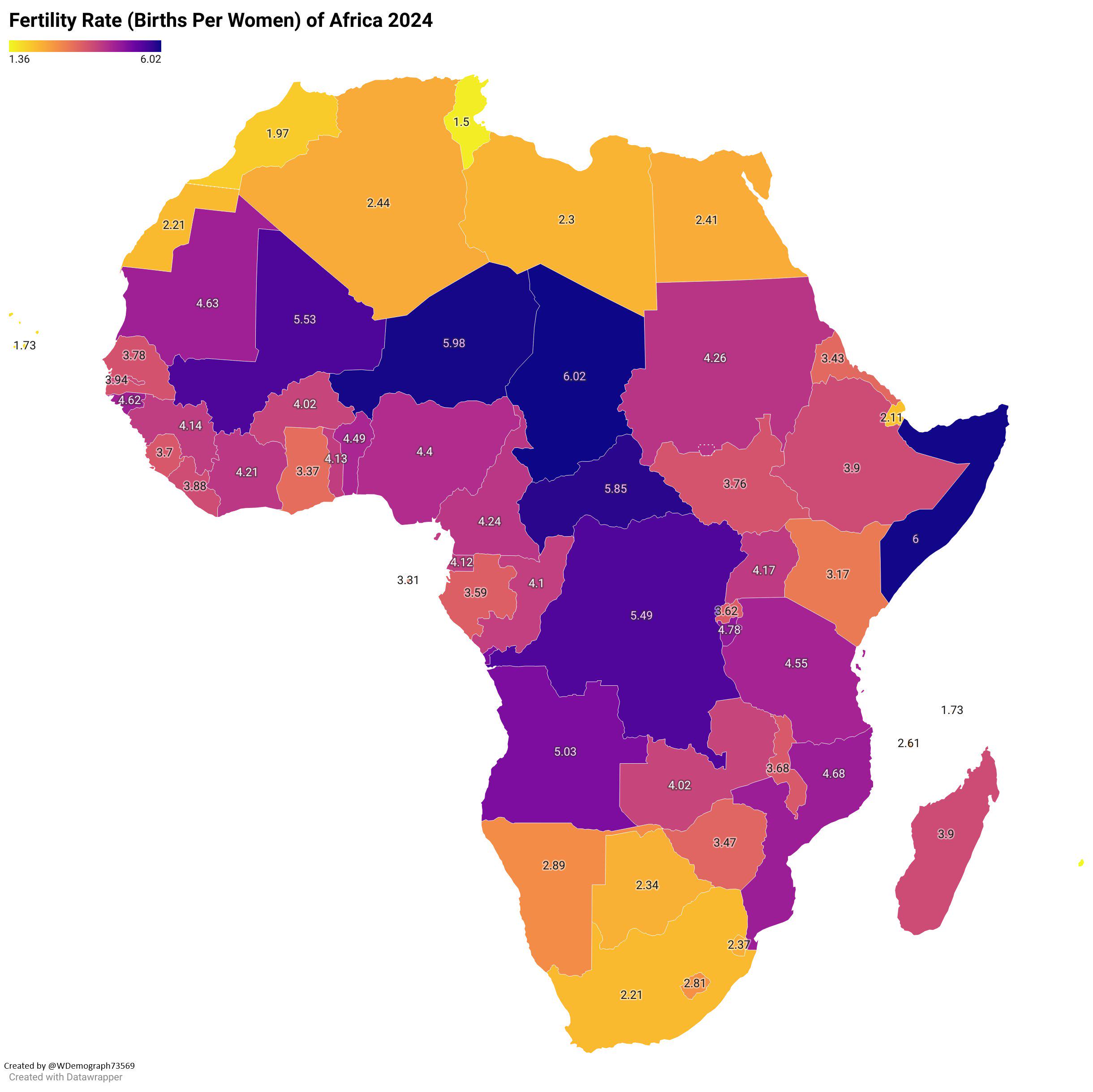Fertility Rate of Africa 2024 Map


Marcus Rodriguez
Historical Geography Expert
Marcus Rodriguez specializes in historical cartography and geographic data analysis. With a background in both history and geography, he brings unique...
Geographic Analysis
What This Map Shows
The "Fertility Rate of Africa 2024 Map" provides a comprehensive overview of the average number of children born per woman across various African countries. This visualization showcases regional differences in fertility rates, highlighting how cultural, economic, and healthcare factors influence reproductive patterns across the continent. By analyzing this map, we can gain insights into population growth trends and the implications for future socio-economic development in Africa.
Deep Dive into Fertility Rates in Africa
Fertility rates are a crucial demographic indicator, reflecting not just the number of children women bear in their lifetimes, but also broader societal trends. In Africa, fertility rates range widely from country to country, influenced by various factors, including education, healthcare accessibility, cultural norms, and economic conditions.
Interestingly, many Sub-Saharan African nations exhibit some of the highest fertility rates globally. For instance, Niger leads with a staggering average of about 6.9 children per woman, reflecting deep-rooted cultural values that emphasize large families. In contrast, countries like Tunisia and Mauritius showcase significantly lower fertility rates, around 1.9 and 1.5 respectively, likely due to higher levels of education and access to family planning services. This stark contrast raises questions about the underlying causes of such divergent fertility patterns.
As we examine the factors influencing fertility rates, it's important to consider education. In many African nations, particularly those with high fertility rates, women's educational attainment is often lower. Education empowers women to make informed choices about family planning and reproductive health, leading to smaller, healthier families. In contrast, countries that have invested in women's education tend to experience declining fertility rates, showcasing a clear correlation between education and reproductive choices.
Healthcare access is another critical factor. Countries with robust healthcare systems, including access to contraception and maternal health services, generally report lower fertility rates. For example, South Africa and Kenya have made significant strides in improving healthcare access, contributing to fertility rates of approximately 2.4 and 3.4 respectively. However, in several West African nations, limited healthcare access continues to drive higher fertility rates, demonstrating the need for ongoing investment in healthcare infrastructure.
Moreover, economic conditions play a vital role in shaping fertility trends. Nations experiencing economic challenges often see higher fertility rates as families may rely on larger numbers of children for labor or support in old age. Conversely, in economies that are growing and providing more job opportunities, families tend to opt for fewer children, aligning with global trends observed in developed nations.
Regional Analysis
Diving deeper into the regional differences presented in the map, we observe distinct fertility patterns across Africa.
In North Africa, countries like Egypt and Libya have fertility rates around 3.1 and 2.9, reflecting a more urbanized lifestyle, increased education levels, and better access to healthcare. This contrasts sharply with the Sahel region, where countries like Mali and Burkina Faso exhibit some of the highest fertility rates on the continent, averaging over 5.5 children per woman. The cultural significance of family and limited access to family planning resources are pivotal in these areas.
Moving to East Africa, nations such as Ethiopia and Tanzania show moderate fertility rates of about 4.6 and 4.9, respectively. However, within East Africa, there is a notable difference between urban and rural areas. Urban centers tend to have lower fertility rates due to better education and healthcare access, whereas rural areas often maintain higher rates.
In Southern Africa, we find a mix of trends. While South Africa's fertility rate is around 2.4, neighboring countries like Zimbabwe and Zambia report higher rates of approximately 3.6 and 4.2. Economic factors, health care availability, and cultural attitudes toward family size contribute to these variations.
Significance and Impact
Understanding fertility rates in Africa holds significant implications for future planning and development. As the continent continues to experience rapid population growth, with projections suggesting it could double by 2050, the challenges posed by high fertility rates could become increasingly complex. Urbanization, environmental sustainability, and economic development are all impacted by population dynamics.
Have you noticed that countries with proactive family planning policies often experience more sustainable growth? The correlation is evident; nations that prioritize reproductive health education, access to contraception, and women's empowerment tend to handle population growth more effectively. This has real-world implications, as high fertility can strain resources, lead to increased poverty levels, and hinder economic development.
Moreover, the changing landscape of fertility rates can influence migration patterns, labor markets, and social services. Countries that invest in education and healthcare are more likely to see a demographic transition, moving toward a balanced population growth that supports both economic growth and social stability.
In conclusion, as we analyze the "Fertility Rate of Africa 2024 Map," it becomes evident that understanding these patterns is crucial for policymakers, educators, and healthcare providers alike. By addressing the underlying factors that contribute to fertility trends, Africa can work toward a future that balances population growth with sustainable development, ultimately improving the quality of life for its citizens.
Visualization Details
- Published
- August 14, 2025
- Views
- 142
Comments
Loading comments...